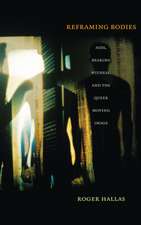Singing For Life: HIV/AIDS and Music in Uganda
Autor Gregory Barzen Limba Engleză Hardback – 28 noi 2005
Through case studies, song texts, interviews, and testimonies, Singing for Life: HIV/AIDS and Music in Uganda examines the links between the decline in Uganda’s infection rate and grassroots efforts that make use of music, dance, and drama. Only when supported and encouraged by such performances drawing on localized musical traditions have medical initiatives taken root and flourished in local healthcare systems. Gregory Barz shows how music can be both a mode of promoting health and a force for personal therapy, presenting a cultural analysis of hope and healing.
Preț: 766.00 lei
Preț vechi: 1103.84 lei
-31% Nou
Puncte Express: 1149
Preț estimativ în valută:
146.59€ • 152.48$ • 121.02£
146.59€ • 152.48$ • 121.02£
Carte tipărită la comandă
Livrare economică 14-28 aprilie
Preluare comenzi: 021 569.72.76
Specificații
ISBN-13: 9780415972895
ISBN-10: 0415972892
Pagini: 276
Ilustrații: 33 b/w images, 1 table and 32 halftones
Dimensiuni: 152 x 229 x 20 mm
Greutate: 0.55 kg
Ediția:1
Editura: Taylor & Francis
Colecția Routledge
Locul publicării:Oxford, United Kingdom
ISBN-10: 0415972892
Pagini: 276
Ilustrații: 33 b/w images, 1 table and 32 halftones
Dimensiuni: 152 x 229 x 20 mm
Greutate: 0.55 kg
Ediția:1
Editura: Taylor & Francis
Colecția Routledge
Locul publicării:Oxford, United Kingdom
Notă biografică
Gregory Barz is Assistant Professor of ethnomusicology and anthropology at Vanderbilt University. He lives in Nashville, TN.
Cuprins
Foreword by Jim Wooten, Acknowledgments, Acronyms Used in the Text, Recorded Selections on the Compact Disc, List of Figures, Orthography, Prelude: “Those Who Do Not Listen to Our Songs and Change Their Behavior Will Land in Problems”, Introduction: “Music Is Taken as a Medicine”: Singing for Life in a Time of AIDS, Chapter 1: HIV/AIDS, Jackfruit, and Banana Weevils: Music and Medical Interventions in Uganda, Interlude 1: Florence Kumunhyu’s Testimony, Chapter 2: “What You Sing Nourishes Your Body Like Food”, Interlude 2: “Our Problems Are Bigger than AIDS”: A Conversation with Dr. Alex Muganzi Muganga, Chapter 3: “No One Will Listen to Us Unless We Bring Our Drums!”: AIDS and Women’s Music Performance in Uganda, Interlude 3: “Stick to One Person”: Nawaikoke Village Women’s Ensemble, Chapter 4: “Today We Have Naming of Parts”: Languaging AIDS Through Music, Interlude 4: Excerpts from an Interview with the Bukato Youth Fellowship, Chapter 5: “Singing in a Language AIDS Can Hear”: Music, AIDS, and Religion, Interlude 5: Conversation with Faustus Baziri, Chapter 6: Re-Memorying Memory: HIV/AIDS and the Performance of Cultural Memory, Interlude 6: TASO Drama Group Testimonies, Conclusion: “Getting the Message Across Without Music Is Sometimes Shaky”, Afterword, Appendix, Notes, Works Cited, Index
Recenzii
'...he investigates how song texts refer to HIV/AIDS, and how women suffering from HIV/AIDS have become empowered through their music, dance and drama presentations...an excellent book that should be read by medical professionals, social workers and musicologists.' Lois Ann Anderson, University of Wisconsin-Madison














